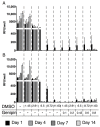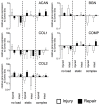Genipin-Enhanced Fibrin Hydrogel and Novel Silk for Intervertebral Disc Repair in a Loaded Bovine Organ Culture Model
- PMID: 29937524
- PMCID: PMC6163705
- DOI: 10.3390/jfb9030040
Genipin-Enhanced Fibrin Hydrogel and Novel Silk for Intervertebral Disc Repair in a Loaded Bovine Organ Culture Model
Abstract
(1) Background: Intervertebral disc (IVD) repair represents a major challenge. Using functionalised biomaterials such as silk combined with enforced hydrogels might be a promising approach for disc repair. We aimed to test an IVD repair approach by combining a genipin-enhanced fibrin hydrogel with an engineered silk scaffold under complex load, after inducing an injury in a bovine whole organ IVD culture; (2) Methods: Bovine coccygeal IVDs were isolated from ~1-year-old animals within four hours post-mortem. Then, an injury in the annulus fibrosus was induced by a 2 mm biopsy punch. The repair approach consisted of genipin-enhanced fibrin hydrogel that was used to fill up the cavity. To seal the injury, a Good Manufacturing Practise (GMP)-compliant engineered silk fleece-membrane composite was applied and secured by the cross-linked hydrogel. Then, IVDs were exposed to one of three loading conditions: no load, static load and complex load in a two-degree-of-freedom bioreactor for 14 days. Followed by assessing DNA and matrix content, qPCR and histology, the injured discs were compared to an uninjured control IVD that underwent the same loading profiles. In addition, the genipin-enhanced fibrin hydrogel was further investigated with respect to cytotoxicity on human stem cells, annulus fibrosus, and nucleus pulposus cells; (3) Results: The repair was successful as no herniation could be detected for any of the three loading conditions. Disc height was not recovered by the repair DNA and matrix contents were comparable to a healthy, untreated control disc. Genipin resulted being cytotoxic in the in vitro test but did not show adverse effects when used for the organ culture model; (4) Conclusions: The current study indicated that the combination of the two biomaterials, i.e., genipin-enhanced fibrin hydrogel and an engineered silk scaffold, was a promising approach for IVD repair. Furthermore, genipin-enhanced fibrin hydrogel was not suitable for cell cultures; however, it was highly applicable as a filler material.
Keywords: bioreactor; cell activity; fibre-reinforced hydrogel; fibrin; genipin; histology; intervertebral disc; mechanical loading; organ culture; qPCR; repair; silk.
Conflict of interest statement
The authors declare no conflict of interest; Michael Wöltje was affiliated with Spintec Engineering GmbH, Aachen, Germany. We have no other conflicts of interest to disclose.
Figures








Similar articles
-
Ex-vivo biomechanics of repaired rat intervertebral discs using genipin crosslinked fibrin adhesive hydrogel.J Biomech. 2020 Dec 2;113:110100. doi: 10.1016/j.jbiomech.2020.110100. Epub 2020 Oct 28. J Biomech. 2020. PMID: 33142205 Free PMC article.
-
Genipin-crosslinked fibrin seeded with oxidized alginate microbeads as a novel composite biomaterial strategy for intervertebral disc cell therapy.Biomaterials. 2022 Aug;287:121641. doi: 10.1016/j.biomaterials.2022.121641. Epub 2022 Jun 17. Biomaterials. 2022. PMID: 35759923 Free PMC article.
-
Mechanical restoration and failure analyses of a hydrogel and scaffold composite strategy for annulus fibrosus repair.Acta Biomater. 2016 Jan;30:116-125. doi: 10.1016/j.actbio.2015.11.015. Epub 2015 Nov 11. Acta Biomater. 2016. PMID: 26577987 Free PMC article.
-
A review of the application of reinforced hydrogels and silk as biomaterials for intervertebral disc repair.Eur Cell Mater. 2017 Oct 24;34:271-290. doi: 10.22203/eCM.v034a17. Eur Cell Mater. 2017. PMID: 29064532 Review.
-
Role of biomechanics in intervertebral disc degeneration and regenerative therapies: what needs repairing in the disc and what are promising biomaterials for its repair?Spine J. 2013 Mar;13(3):243-62. doi: 10.1016/j.spinee.2012.12.002. Epub 2013 Jan 29. Spine J. 2013. PMID: 23369494 Free PMC article. Review.
Cited by
-
Mechanical and biological characterization of a composite annulus fibrosus repair strategy in an endplate delamination model.JOR Spine. 2020 Jul 16;3(4):e1107. doi: 10.1002/jsp2.1107. eCollection 2020 Dec. JOR Spine. 2020. PMID: 33392447 Free PMC article.
-
Engineering extracellular matrix-based hydrogels for intervertebral disc regeneration.Front Bioeng Biotechnol. 2025 May 1;13:1601154. doi: 10.3389/fbioe.2025.1601154. eCollection 2025. Front Bioeng Biotechnol. 2025. PMID: 40375978 Free PMC article. Review.
-
Comparison of biomechanical studies of disc repair devices based on a systematic review.Spine J. 2020 Aug;20(8):1344-1355. doi: 10.1016/j.spinee.2020.02.007. Epub 2020 Feb 22. Spine J. 2020. PMID: 32092506 Free PMC article.
-
Production and Characterization of Porous Fibroin Scaffolds for Regenerative Medical Application.In Vivo. 2019 May-Jun;33(3):757-762. doi: 10.21873/invivo.11536. In Vivo. 2019. PMID: 31028194 Free PMC article.
-
The Functional Role of Interface Tissue Engineering in Annulus Fibrosus Repair: Bridging Mechanisms of Hydrogel Integration with Regenerative Outcomes.ACS Biomater Sci Eng. 2020 Dec 14;6(12):6556-6586. doi: 10.1021/acsbiomaterials.0c01320. Epub 2020 Nov 18. ACS Biomater Sci Eng. 2020. PMID: 33320618 Free PMC article.
References
-
- Vos T., Flaxman A.D., Naghavi M., Lozano R., Michaud C., Ezzati M., Shibuya K., Salomon J.A., Abdalla S., Aboyans V., et al. Years lived with disability (YLDs) for 1160 sequelae of 289 diseases and injuries 1990–2010: A systematic analysis for the Global Burden of Disease Study 2010. Lancet. 2012;380:2163–2196. doi: 10.1016/S0140-6736(12)61729-2. - DOI - PMC - PubMed
-
- Pennicooke B., Hussain I., Berlin C., Sloan S.R., Borde B., Moriguchi Y., Lang G., Navarro-Ramirez R., Cheetham J., Bonassar L.J., et al. Annulus Fibrosus Repair Using High-Density Collagen Gel: An In vivo Ovine Model. Spine. 2017;43:E208–E215. doi: 10.1097/BRS.0000000000002334. - DOI - PMC - PubMed
-
- Elliott W.H., Bonani W., Maniglio D., Motta A., Tan W., Migliaresi C. Silk Hydrogels of Tunable Structure and Viscoelastic Properties Using Different Chronological Orders of Genipin and Physical Cross-Linking. ACS Appl. Mater. Interfaces. 2015;7:12099–12108. doi: 10.1021/acsami.5b02308. - DOI - PMC - PubMed
-
- Long R.G., Bürki A., Zysset P., Eglin D., Grijpma D.W., Blanquer S.B., Hecht A.C., Iatridis J.C. Mechanical restoration and failure analyses of a hydrogel and scaffold composite strategy for annulus fibrosus repair. Acta Biomater. 2016;30:116–125. doi: 10.1016/j.actbio.2015.11.015. - DOI - PMC - PubMed
LinkOut - more resources
Full Text Sources
Other Literature Sources

